Victor Olaiya: Nigeria's 'evil genius' trumpeter who influenced Fela Kuti
THE DEVILS GABRIEL
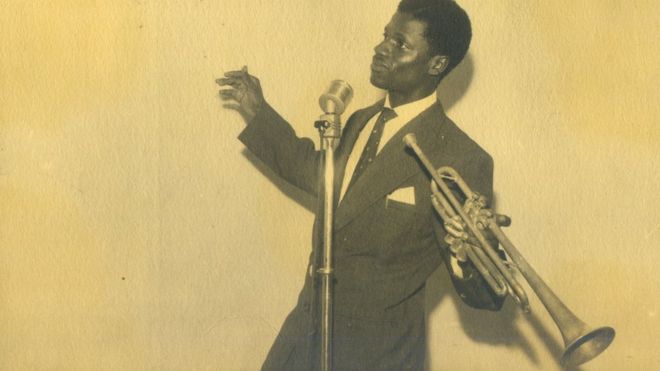
MYDRIM GALLERY
YOUTUBE MUSIC AT THE END OF ARTICLES
YOUTUBE MUSIC AT THE END OF ARTICLES
Nigeria has been mourning music legend Victor Olaiya, who created Nigeria's highlife rhythms and influenced a generation of musicians including Fela Anikulapo-Kuti. Nduka Orjinmo looks back at the life of the trumpeter, who died last month at the age of 89.
Just like the well-turned out government filing clerk that he was, Olaiya always carried a pen in his breast pocket. This was not for noting instructions that had to be precisely followed, but rather because he needed to write down the musical notes and phrases as they came to him.
This was at the beginning of the 1950s, his early days as a performer, when the trumpeter was trying to create Nigeria's highlife rhythms.
More musician than bureaucrat
At this stage, music was something he did in his spare time and Olaiya thought he had lost his job in the civil service when his boss saw a newspaper photo of him performing at a nightclub.
Instead, he was told that he was a better musician than a bureaucrat at the survey department of Lagos mainland local government.
He left the job and took on music full time.
Olaiya's family Victor Olaiya

Born to wealthy Yoruba parents in the southern city of Calabar, Olaiya had an early start in music.
His father was a church organist and his mother a folk singer from the western city of Oyo.
He was also influenced by Caribbean calypso and included the popular song Sly Mongoose in his repertoire that he recalled first hearing when he was nine years old.
As a teenager, though, he was taught Western classical music, and played the clarinet and French horn in his school orchestra in eastern Nigeria.
Years later, wielding his gold trumpet and dabbing his face with a white handkerchief, Olaiya would perform a new type of music in Nigeria that would go on to inspire a young Fela Anikulapo-Kuti among others.
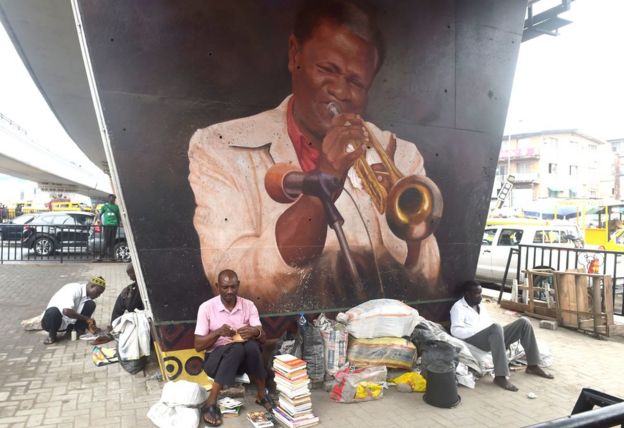
Victor Olaiya is hailed as the father of Nigerian highlife music
After his secondary school, Olaiya moved to Lagos where he joined the Lagos City Orchestra and then the band of composer Sammy Akpabot, playing ballroom music for wealthy urban audiences.
But it was as the head of Bobby Benson's Alfa Carnival Group that his talent would be properly nurtured.
Benson took a number of musicians under his wing and it was here that Olaiya polished the skills that would help him form his own band, the Cool Cats.
Listening to the recordings now, the gentle swinging rhythm and the prominence of the horn section, you sense a sepia tinge to Olaiya's songs.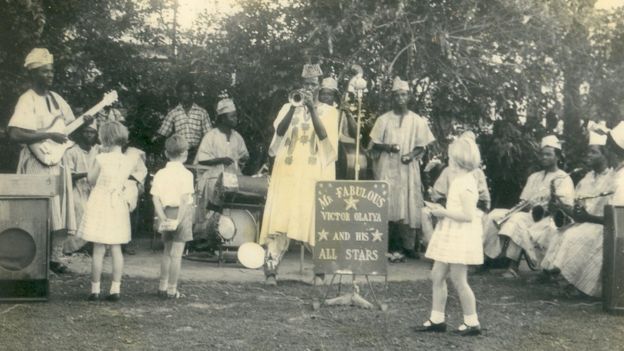

After his secondary school, Olaiya moved to Lagos where he joined the Lagos City Orchestra and then the band of composer Sammy Akpabot, playing ballroom music for wealthy urban audiences.
But it was as the head of Bobby Benson's Alfa Carnival Group that his talent would be properly nurtured.
Benson took a number of musicians under his wing and it was here that Olaiya polished the skills that would help him form his own band, the Cool Cats.
Listening to the recordings now, the gentle swinging rhythm and the prominence of the horn section, you sense a sepia tinge to Olaiya's songs.

MYDRIM GALLERY
Victor Olaiya rose to fame as Nigeria was moving away from British rule
They evoke memories of the fading British Empire and transition to independence, conjuring up images of afro hair combed into a dome, of middle-class Nigerians appearing overdressed in tuxedos and gowns with a cigarette neatly tucked between the fingers.
By the late 1950s, the colonial administrators were on their way out and a young generation of educated Africans was about to take over.
As the disco bars and ballrooms gradually thinned out of the British and their music, in stepped the elite class of Africans seeking that same high life but fused with their own culture.
And the bands responded to satisfy their new patrons, incorporating local rhythms and melodies into their repertoire.
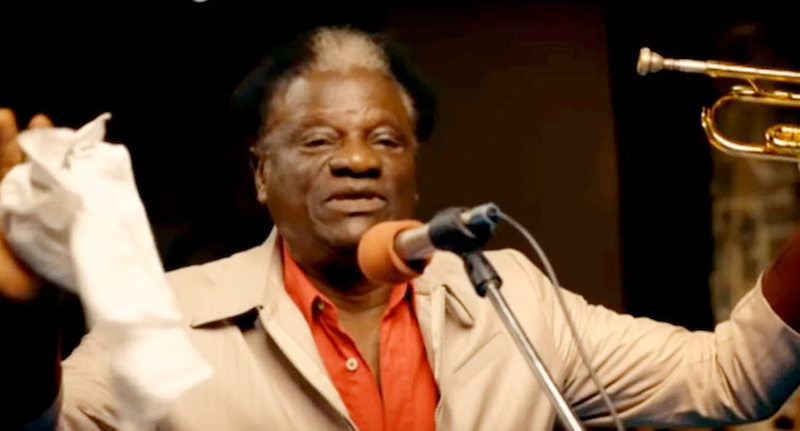
You may also like:
King of jazz: The Nigerian saxophonist inspiring generations
Eyeing big money in Nigerian music
How Fela's legacy lives on
The story of Ghanaian highlife
The songs were romantic and the lyrics, which to today's eyes appear sexist, often used erotic imagery.
Olaiya's 1961 track Adelebo Tonwoku (Single Lady Looking for a Husband) says that if a woman, referred to as "Cinderella shaking her buttocks", finds a husband she should "forgo education".
As a musical term, highlife was first used in Ghana in the 1920s to describe a band playing a fusion of foreign and local instruments driven by multiple guitars and horns.
Olaiya's influence came from Ghana, as he was a keen admirer of the Tempo band of highlife legend ET Mensah, who toured Nigeria multiple times from 1951.
When Olaiya formed his Cool Cats band, he adopted Mensah's style and had Ghanaian Sammy Lartey as saxophonist. Years later, Olaiya and Mensah would release a joint album.
In bombastic style, Olaiya was once described by a newspaper editor as "the evil genius of highlife", perhaps because once someone heard his music it was impossible not to dance.
His music became so popular that in 1960 he played at the party to celebrate Nigeria's independence in front of Queen Elizabeth's sister, Princess Margaret.
They evoke memories of the fading British Empire and transition to independence, conjuring up images of afro hair combed into a dome, of middle-class Nigerians appearing overdressed in tuxedos and gowns with a cigarette neatly tucked between the fingers.
By the late 1950s, the colonial administrators were on their way out and a young generation of educated Africans was about to take over.
As the disco bars and ballrooms gradually thinned out of the British and their music, in stepped the elite class of Africans seeking that same high life but fused with their own culture.
And the bands responded to satisfy their new patrons, incorporating local rhythms and melodies into their repertoire.

You may also like:
King of jazz: The Nigerian saxophonist inspiring generations
Eyeing big money in Nigerian music
How Fela's legacy lives on
The story of Ghanaian highlife
The songs were romantic and the lyrics, which to today's eyes appear sexist, often used erotic imagery.
Olaiya's 1961 track Adelebo Tonwoku (Single Lady Looking for a Husband) says that if a woman, referred to as "Cinderella shaking her buttocks", finds a husband she should "forgo education".
As a musical term, highlife was first used in Ghana in the 1920s to describe a band playing a fusion of foreign and local instruments driven by multiple guitars and horns.
Olaiya's influence came from Ghana, as he was a keen admirer of the Tempo band of highlife legend ET Mensah, who toured Nigeria multiple times from 1951.
When Olaiya formed his Cool Cats band, he adopted Mensah's style and had Ghanaian Sammy Lartey as saxophonist. Years later, Olaiya and Mensah would release a joint album.
In bombastic style, Olaiya was once described by a newspaper editor as "the evil genius of highlife", perhaps because once someone heard his music it was impossible not to dance.
His music became so popular that in 1960 he played at the party to celebrate Nigeria's independence in front of Queen Elizabeth's sister, Princess Margaret.
Fela comes to Olaiya
Olaiya was a multi-linguist and sang in Twi, Igbo, Efik, Pidgin and Yoruba and his band would go on to serve as a training ground for musicians who would revolutionise music in Africa.
Chief among those that interned with Olaiya was Fela, creator of the Afrobeat genre and arguably Nigeria's most influential musician.
Fresh from secondary school in 1957, Fela spent time playing with Olaiya's Cool Cats in Lagos and headed another of the maestro's bands.
Olaiya recognised a prodigy and gave him a platform, in the same way that he had been supported by Benson.
Fela's drummer, Tony Allen, was also among those who played with Olaiya. Other notable musicians that passed through his band were guitar wizard Victor Uwaifo, juju musician Dele Ojo and saxophonist Yinusa Akinnibosun.

MYDRIM GALLERY
Olaiya collaborated with American soul musician James Brown (R) for the 1970 album Up-To-Date Mover
By 1970, under the influence of James Brown, Olaiya had branched into soul and funk music. His Up-to-Date Mover album of that year included five tracks co-written with Brown.
But Olaiya will forever be associated with highlife, and this gradually faded from the scene until the genre became a stacked collection of dusty vinyl for senior citizens who hung onto the memories of an era when "things were good".
The Cool Cats were no longer cool, as first Fela's Afrobeat and later Afro hop swept succeeding generations off their feet.
Olaiya tried to keep up in later decades by doing things like shooting music videos but he never looked comfortable with the format.
He was used to the disco bars, the big orchestra and the larger-than-life bands performing for dandy crowds.
By 1970, under the influence of James Brown, Olaiya had branched into soul and funk music. His Up-to-Date Mover album of that year included five tracks co-written with Brown.
But Olaiya will forever be associated with highlife, and this gradually faded from the scene until the genre became a stacked collection of dusty vinyl for senior citizens who hung onto the memories of an era when "things were good".
The Cool Cats were no longer cool, as first Fela's Afrobeat and later Afro hop swept succeeding generations off their feet.
Olaiya tried to keep up in later decades by doing things like shooting music videos but he never looked comfortable with the format.
He was used to the disco bars, the big orchestra and the larger-than-life bands performing for dandy crowds.
Recognised by a later generation
There were attempts to introduce his music to a new audience.
In 2013, Tuface Idibia, a music legend in his own right, remixed Olaiya's Baby Jowo. It was a homage to another era but only underlined how things had changed.
A handful of highlife musicians are still scattered in the eastern and western parts of Nigeria but their tunes are now mostly heard at funerals.
When Olaiya is laid to rest, perhaps a band led by an immaculately turned out trumpeter will be at the front of the procession?
And when he is lowered into the ground, it may be more than flesh that is returning to dust. The highlife music he pioneered may just be buried along with him.
Alhaji Alade Odunewu of the Daily Times described him as "The Evil Genius of Highlife." Contents. 1 Early life and career; 2 Personal life; 3 Music; 4 Discography; 5 Further reading; 6 References; 7 External links. Early life and career[edit]. Olaiya was born on 31 December 1930, in Calabar, Cross River ... During the Nigerian Civil War of 1967–70, Olaiya was given the rank of a ...
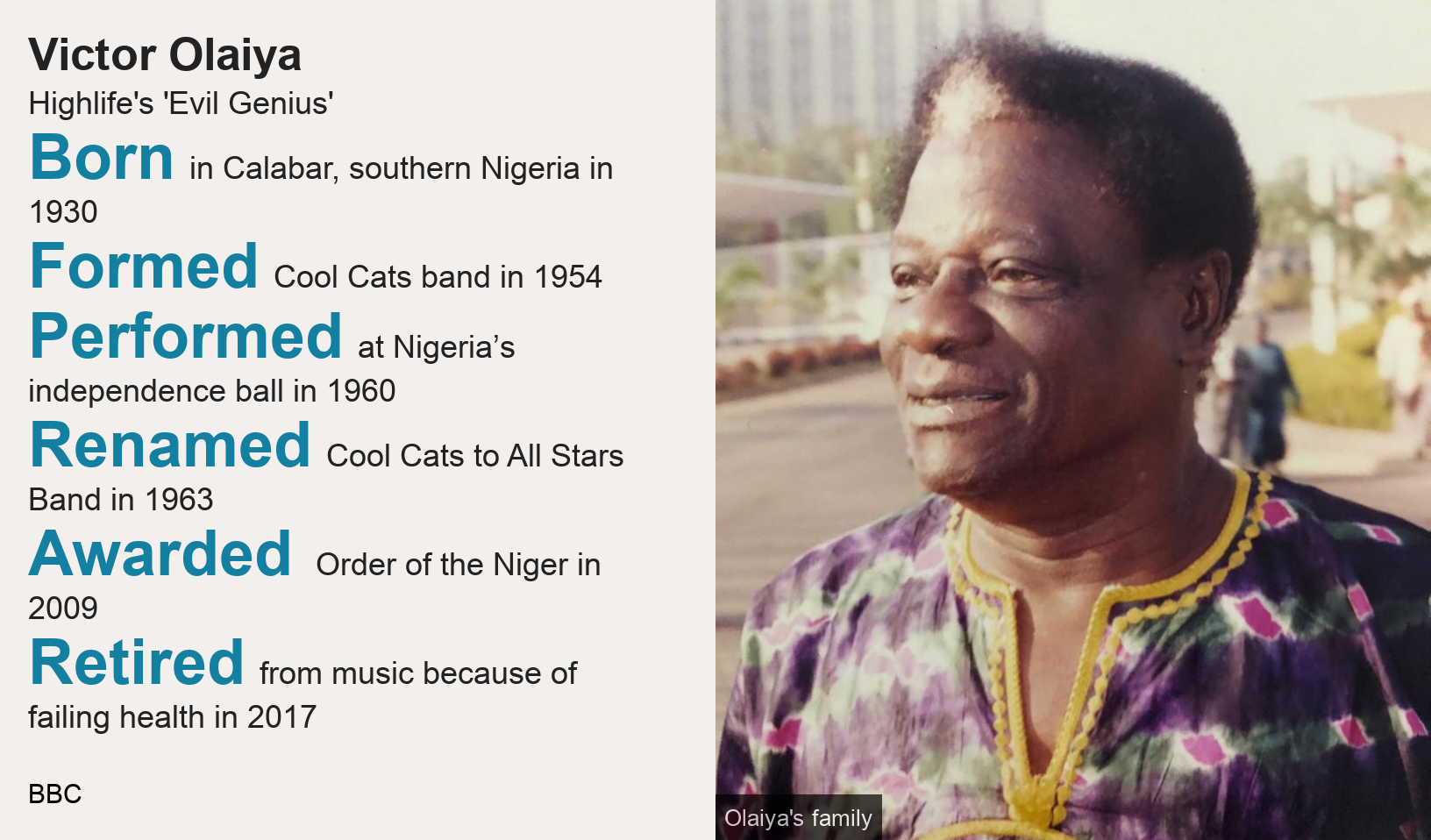
Nigeria’s Victor Olaiya: Trumpeter and ‘evil genius’ of highlife music (1931-2020)
Olaiya revolutionized highlife dance music on the West African coast
Posted 19 February 2020

Screenshot of a video about Victor Olaiya's history of album covers, by Andrew MusicOdyssey via YouTube.
Editor's note: This essay was written by Dami Ajayi and first published in the Lagos Review. This version was lightly edited and published here with permission by Dami Ajayi.
Victor Abimbola Olaiya, highlife maestro, trumpeter, vocalist and band leader, died in the afternoon of Wednesday February 12, 2020. He was 89 years old.
Nigeria’s Victor Olaiya: Trumpeter and ‘evil genius’ of highlife music (1931-2020)
Olaiya revolutionized highlife dance music on the West African coast
Posted 19 February 2020

Screenshot of a video about Victor Olaiya's history of album covers, by Andrew MusicOdyssey via YouTube.
Editor's note: This essay was written by Dami Ajayi and first published in the Lagos Review. This version was lightly edited and published here with permission by Dami Ajayi.
Victor Abimbola Olaiya, highlife maestro, trumpeter, vocalist and band leader, died in the afternoon of Wednesday February 12, 2020. He was 89 years old.
An accomplished trumpeter, Olaiya was one of the key figures of highlife, the popular dance music that became the rave on the West African Coast from the 50s.
Did this thread in 2018 on Highlife music and I recall it as I do a thread this morning on the Evil Genius of Highlife music himself, Victor “Papingo Devalaya” Olaiya.
Olaiya was born in Calabar to Yoruba parents and was a very brilliant chap growing up, with a love for music. https://t.co/N9zXX480yP
— Demola Olarewaju (@DemolaRewaju) February 14, 2020
Highlife as a musical form originated from Sierra Leone and Ghana, but it was in Ghana that it gained its name as a ballroom dance enjoyed by the “elitist natives.”
In 1952, Olaiya formed his own band called the Cool Cats, which was later renamed the All Stars Band.

Victor Olaiya's All Stars Soul International (CD digipack + 16 page booklet/Heavy vinyl LP gatefold) Vampisoul, 2009-04-21. Image credit: Paris DJs, used with permission.
Emmanuel Teytey Mensah, a Ghanaian pharmacist — famed to have knocked out his incisors for the greater calling of blowing the trumpet — is often seen as one of the founding fathers of highlife music. Another founding father was Bobby Benson whose Jam Orchestra was the stomping ground for some of the finest highlife musicians Nigeria has ever had.
A young Victor Olaiya played in Bobby Benson’s Jam Orchestra.
Historians are not exact about how highlife music became a Nigerian staple, but by the late 40s and 50s, this music held Nigeria’s nightlife by the scruff of the neck. Hotel dance halls and night clubs had resident bands and Saturday nights were special.
By the 50s, Victor Olaiya was already a highlife music star. A young Fela Kuti had a stint as a trumpeter in Olaiya’s Cool Cats band before his own career as a band leader took off.
Victor Olaiya played at the Independence Ball before important dignitaries.
If there is any music that encapsulates the nostalgia and optimism of Nigeria’s independence, it is highlife music. Imagine the piquant tunes of the trumpet piercing the night as the Union Jack was lowered and Nigeria’s National Flag was hoisted, fluttering bi-colour, triband and proud.

Screenshot of Victor Olaiya's album cover from YouTube video by Andrew MusicOdyssey.
When this optimism was dashed in the ethnic flavoured coup and countercoup that devolved into a civil war, highlife music also tracked this era.
War hardly provided an opportunity for nocturnal pleasures because curfews emptied the streets of people.
There was also the fact that a fine proportion of highlife musicians and instrumentalists were also from eastern Nigerian, hence their relocation behind the tentative territories of Biafra which brutally shrunk in a war that left millions of people dead.
Even though highlife music seemed intertwined with politics, it was in itself, deeply apolitical. It had no pretensions about what it was: it was dance music for dance halls, for socialites, for nocturnal men and women, for wiggling waists, for quivering buttocks and for theatrical leg works.
Victor Olaiya held Lagos down when the city became empty of highlife stars.
He had an honorary army title and his band played for the Nigerian troops to entertain them during the war. In terms of honour, he was also conferred an honorary doctorate degree at the First Jazz International Festival in Prague. By far his most enduring honour was being called the “evil genius” of highlife for his ability to keep people on their feet.
His style of music features a unique way of playing the trumpet and his ability to sing in several Nigerian languages made his highlife a somewhat nationalistic endeavor. The Stadium Hotel in Surulere, Lagos, perhaps so named for its proximity to the National Stadium, was a famous highlife spot during his active years.
Today, it stands in a state of quaint disrepair yet quite functional for the old heads and unusual young oddballs and inquisitive creatures who fancy highlife music.
Since old age and ill-health left Victor Olaiya a shadow of his old self, Bayowa Olaiya, banker by day and son of Victor Olaiya, holds court and renders some of the finest tunes of his now deceased father.
Victor Abimbola Olaiya (born 31 December 1930), also known as Dr Victor Olaiya, is a Nigerian trumpeter who plays in the highlife style. Though extremely famous in Nigeria during the 1950s and early 1960s, Olaiya received little recognition outside his native country. Alhaji Alade Odunewu of the Daily Times described him as "The Evil Genius of Highlife. Olaiya was born on 31 December 1930, in Calabar, Cross River State, the 20th child of a family of 24. His parents, Alfred Omolona Olaiya and Bathsheba Owolabi Motajo, came from Ijesha-Ishu in Ekiti State. Olaiya came from a very rich family. His father's house called Ilọijọs Bar stood on 2 Bamgbose Street, Lagos Island, until it was demolished on September 11, 2016. At an early age he learned to play the Bombardon and the French Horn. After leaving school he moved to Lagos, where he passed the school certificate examination in 1951 and was accepted by Howard University, US, to study civil engineering. Olaiya instead pursued a career as a musician, to the disapproval of his parents. He played with the Sammy Akpabot Band, was leader and trumpeter for the Old Lagos City Orchestra and joined the Bobby Benson Jam Session Orchestra.

No comments:
Post a Comment